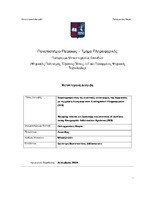Χαρτογραφώντας τις σωστικές ανασκαφές της Άμφισσας με τη χρήση Γεωγραφικών Συστημάτων Πληροφοριών (GIS)
Mapping rescue archaeology excavations of Amfissa using Geographic Information Systems (GIS)

View/
Keywords
Σωστική αρχαιολογία ; Γεωγραφικά Συστήματα Πληροφοριών (GIS) ; Έξυπνη πολιτιστική κληρονομιά ; Έξυπνες πόλειςAbstract
This thesis examines the use of Geographic Information Systems (GIS) in documenting and analyzing rescue excavations conducted in Afissa, Greece, from 1969 to 2015. The study highlights GIS as a transformative tool for managing archaeological data, bridging cultural heritage preservation and urban development. By creating a geospatial database, the research systematically organizes excavation data, including site chronology, artifact types, and contextual details such as photographs. This database enhances accessibility for archaeologists, policymakers and public fostering decision-making and public engagement.
Research situates its finding within the broader framework of Smart Cultural Heritage, demonstrating how digital tools like GIS integrate archaeological heritage management into urban planning. GIS enables the visualization and analysis of spatial relationships between historial and modern urban environments, offering insights into settlement patterns and human activity in historical Amfissa.
Methodologically, the thesis outlines the categorization and georeferencing of excavation data to build a robust spatial database. This approach underscores the importance of GIS in addressing challenges posed by rapid urbanization and ensuring sustainable heritage management. By advocating for standardized digital practices, the study contributes to interdisciplinary collaboration and offers a replicable model for similar urban contexts, aligning heritage preservation with modern technical advancements.


